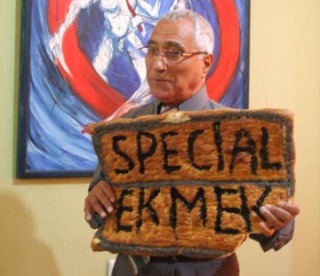Polat-Kaya SUMERIAN AS A DIALECT OF TURKISH (DINGIR,…
| TO WHOM IT MAY CONCERN:
I’m pleased to see that our guru Mr. Polat Kaya is continuing his research and guidance on the subjects related to the place of the Turkish culture and linguistic homage in the world. To this end, I suggest you to read “PART-1: Turkish – Sumerian kinship” written by Polat Kaya in December 2004. Though, it was a response to “K. Loganathan” ulagankmy@yahoo.com, in fact it was for all. Presently Part 2- Sumerian As A Dıalect Of Turkish (Dingir, Bilgamesh, Tur, Utnapishtim) is with us. Frankly, I’m anxious to see and read the episode of Part 3 and more. Polat Kaya’s first article was named: “Sumerian Dravidian and Turkish”. In response to this, K. Loganathan responded by saying, [http://groups.yahoo.com/group/akandabaratam/message/14523]: “Dear Friends, while I am not opposed to Turkish being another variant of SumeruTamil just as perhaps Hungarian, the Pakistani Siraiki and so forth, it does not seem to be reasonable to claim that Sumerian is an evolutionary development of Archaic Turkic language. The time frame of these two languages just does not fit this claim.” To this, Polat Kaya on 28/12/2004 responded (briefly): “I appreciate your understanding that Turkish, Sumerian, Tamil and Hungarian are related languages. However, Turkish is not a variant of SumeruTamil as you put it. On the contrary, it would be more correct to say that Sumerian was a variant of Turkish - as is Tamil. Sumerian, Tamil and Turkish are Turanian languages, and Turanian languages are Turkic, that is, the languages of Tur/Turk peoples. If Sumerian does not appear exactly the same as Turkish, it is because Sumerian, at worst, was a dialect of Turkish - just like present-day dialects of Turkish are - as spoken throughout the present Turkish world.” Additionally, the established presentation of Sumerian is very nebulous. This will become clearer as I go through your comments inthis dialog." He furthered his argument by saying: “The Sumerian language, as it is known at present, has been read through a frosted-glass. That ‘frosted-glass’ window is the so-called ‘Akkadian’ language which is a manufactured language using Sumerian and/or Turkish words and phrases as the source - as spoken at that time. Therefore the Sumerian that is presented to us is very much blurred and Semitized.” He even furthered by saying: “In other words, the Sumerian language is presented to us in a distorted form meaning that its presentation is not truly authentic. When S. N. Kramer wrote about Sumerian, he described it in relation to Turkish by using ‘double negatives’ as if he did not know how to express his thoughts in the positive sense. S. N. Kramer said: ‘Sumerian resembles no little such agglutinative languages as Turkish, Hungarian, and some of the Caucasian languages. In vocabulary, grammar, and syntax, however, Sumerian still stands alone and seems to be unrelated to any other language, living or dead.’” ["The Sumerians", The University of Chicago Press, Chicago and London, 1963, p. 306, under "The Sumerian Language".] This statement by S. N. Kramer, when translated into the positive sense, becomes: “Sumerian resembles very much such agglutinative languages as Turkish, Hungarian, and some of the Caucasian languages.” As can be seen the effect is very much different between the two way of expressing. To demonstrate his point, he gives a Sumerian example and compares it with the corresponding Turkish one: Sumerian statement of "DINGIR.LUGAL-TUR-DA-DINGIR-RA-NI-IR" is written in Turkish as "TENGIR.uLU aGa-AL TUR ADA (ATA), TENGIR-ER ER-IN"… Kaya refers to several Sumerologists’ views in his write-ups to make it sure. In one of them, he refers to Joan Oates's saying: "ENLIL (ELLIL), ‘Lord Wind’, tutelary deity of Nippur, was ANU's son. Like his father he came to be known as ‘Father’ or ‘King’ of the gods and was the first to replace ANU in the mythology. His role as national god of Sumer and bestower of kingship has already been discussed in earlier chapters." ["BABYLON", Thames and Hudson Ltd, London, 1979, p. 172.] John L. Hayes is another Sumerologist who wrote the following: "In the bilingual texts from Ebla, the equivalent of EN-Lil is given as: I-LI-LU. This seems to agree with later Akkadian pronounciation of the name, which also show an assimilation of /Enlil/ > /ILLIL/; some Sumerologists, in fact, transliterate the two signs EN-lil together as ELLIL. (It has also been speculated that the interpretation of the name as ‘Lord Wind’ is a Sumerian folk-etymology, and that the word is of pre-Sumerian etymology.)" ["A Manual Of Sumerian Grammar and Texts", Undena Publications, Malibu, 1990, p. 77.] Of course, in writings of Polat Kaya, the Wind-God ENLIL is nothing but the altered form of the Turkish expression "HAN YEL" meaning "Lord Wind"! I must add to this, a fact that, last year, I had asked our another guru, thank God, the only living Turkish Sumerologist Mrs. Muazzez Ilmiye Çığ (97) had told me that Mr. Polat Kaya was a better choise for me to ask for a “FOREWORD” to write for my book file entitled, “From the Sumerian Era To Present - A MAP OF TURKISH LANGUAGE”. There you are… For more on Polat Kaya’s ideas, please consult with the followings: http://tech.groups.yahoo.com/group/Polat_Kaya/message/318 http://tech.groups.yahoo.com/group/Polat_Kaya/message/319 http://tech.groups.yahoo.com/group/Polat_Kaya/message/321 http://www.polatkaya.net/pantheon_yurt.htm http://www.polatkaya.net/Heracles_Part-1.html and to reach him: tntr@compmore.net Globally yours, M. Ali Sulutas / 22.8.11 |

